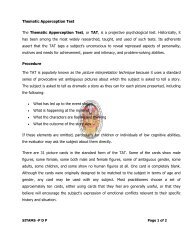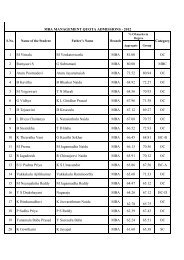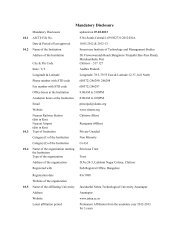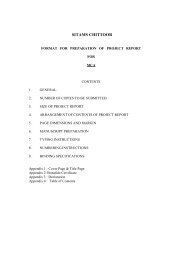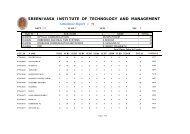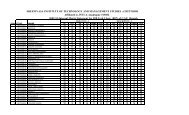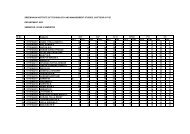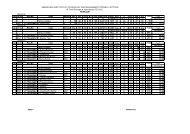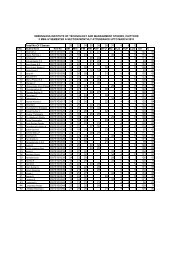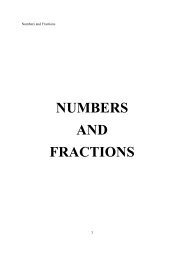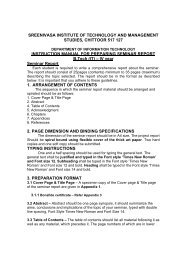SIMPLE INTEREST
SIMPLE INTEREST
SIMPLE INTEREST
Create successful ePaper yourself
Turn your PDF publications into a flip-book with our unique Google optimized e-Paper software.
<strong>SIMPLE</strong><br />
<strong>INTEREST</strong>
MODULE OBJECTIVE<br />
<br />
Interest is the cost of borrowing money. An interest rate is the cost stated as a percent of the<br />
amount borrowed per period of time, usually one year.<br />
<br />
Simple interest is calculated on the original principal only. Accumulated interest from prior<br />
periods is not used in calculations for the following periods. Simple interest is normally used for<br />
a single period of less than a year, such as 30 or 60 days.<br />
<br />
where:<br />
P = principal (original amount borrowed or loaned)<br />
R= interest rate for one period<br />
T = number of periods<br />
IMPORTANT FORMULA<br />
Principal:<br />
The money borrowed or lent out for a certain period is called the principal or the sum.<br />
Interest:<br />
Extra money paid for using other's money is called interest.<br />
Simple Interest (S.I.):<br />
If the interest on a sum borrowed for certain period is reckoned uniformly, then it is called simple<br />
interest.<br />
Let Principal = P, Rate = R% per annum (p.a.) and Time = T years. Then
(i). Simple Intereest =<br />
P x R x T<br />
100<br />
(ii). P = 100 x S.I. ; R = 100 x S.I. and T = 100 x S.I. .<br />
R x T P x T P x R<br />
SOLVED EXAMPLES<br />
1. A sum of money at simple interest amounts to Rs. 815 in 3 years and to Rs. 854 in 4<br />
years. The sum is:<br />
A.Rs. 650 B.Rs. 690<br />
C.Rs. 698 D.Rs. 700<br />
Answer: Option C<br />
Explanation:<br />
S.I. for 1 year = Rs. (854 - 815) = Rs. 39.<br />
S.I. for 3 years = Rs.(39 x 3) = Rs. 117.<br />
Principal = Rs. (815 - 117) = Rs. 698.<br />
2. Mr. Thomas invested an amount of Rs. 13,900 divided in two different schemes A and B<br />
at the simple interest rate of 14% p.a. and 11% p.a. respectively. If the total amount of<br />
simple interest earned in 2 years be Rs. 3508, what was the amount invested in Scheme B?<br />
A.Rs. 6400 B.Rs. 6500<br />
C.Rs. 7200 D.Rs. 7500<br />
E.None of these
Answer: Option A<br />
Explanation:<br />
Let the sum invested in Scheme A be Rs. x and that in Scheme B be Rs. (13900 - x).<br />
Then,<br />
x x 14 x 2 +<br />
(13900 - x) x 11 x 2 = 3508<br />
100 100<br />
28x - 22x = 350800 - (13900 x 22)<br />
6x = 45000<br />
x = 7500.<br />
So, sum invested in Scheme B = Rs. (13900 - 7500) = Rs. 6400.<br />
3. A sum fetched a total simple interest of Rs. 4016.25 at the rate of 9 p.c.p.a. in 5 years.<br />
What is the sum?<br />
A.Rs. 4462.50 B.Rs. 8032.50<br />
C.Rs. 8900 D.Rs. 8925<br />
E.None of these<br />
Answer: Option D<br />
Explanation:<br />
Principal= Rs.<br />
100 x 4016.25<br />
9 x 5<br />
= Rs.<br />
401625<br />
45<br />
= Rs. 8925.<br />
4. How much time will it take for an amount of Rs. 450 to yield Rs. 81 as interest at 4.5%<br />
per annum of simple interest?<br />
A. 3.5 years B.4 years<br />
C. 4.5 years D.5 years<br />
Answer: Option B<br />
Explanation:<br />
Time = 100 x 81 years = 4 years.<br />
450 x 4.5
5. Reena took a loan of Rs. 1200 with simple interest for as many years as the rate of<br />
interest. If she paid Rs. 432 as interest at the end of the loan period, what was the rate of<br />
interest?<br />
A. 3.6 B.6<br />
C. 18 D.Cannot be determined<br />
Answer: Option B<br />
Explanation:<br />
Let rate = R% and time = R years.<br />
Then,<br />
1200 x R x R = 432<br />
100<br />
12R 2 = 432<br />
R 2 = 36<br />
R = 6.<br />
6. A sum of Rs. 12,500 amounts to Rs. 15,500 in 4 years at the rate of simple interest. What<br />
is the rate of interest?<br />
A.3%<br />
B.4%<br />
C.5%<br />
D.6%<br />
E.None of these<br />
Answer: Option D<br />
Explanation:<br />
S.I. = Rs. (15500 - 12500) = Rs. 3000.<br />
Rate = 100 x 3000 % = 6%<br />
12500 x 4<br />
7. A person takes a loan of Rs. 200 at 5% simple interest. He returns Rs. 100 at the end of 1<br />
year. In order to clear his dues at the end of 2 years, he would pay:<br />
A.Rs. 105 B.Rs. 110<br />
C.Rs. 115 D.Rs. 115.50<br />
Answer: Option C<br />
Explanation:<br />
Amount to be paid
= Rs. 100 + 200 x 5 x 1 + 100 x 5 x 1<br />
100 100<br />
= Rs. 115.<br />
8. An automobile financier claims to be lending money at simple interest, but he includes<br />
the interest every six months for calculating the principal. If he is charging an interest of<br />
10%, the effective rate of interest becomes:<br />
A.10%<br />
B.10.25%<br />
C.10.5%<br />
D.None of these<br />
Answer: Option B<br />
Explanation:<br />
Let the sum be Rs. 100. Then,<br />
S.I. for first 6 months = Rs.<br />
S.I. for last 6 months = Rs.<br />
100 x 10 x 1 = Rs. 5<br />
100 x 2<br />
105 x 10 x 1 = Rs. 5.25<br />
100 x 2<br />
So, amount at the end of 1 year = Rs. (100 + 5 + 5.25) = Rs. 110.25<br />
Effective rate = (110.25 - 100) = 10.25%<br />
9.A lent Rs. 5000 to B for 2 years and Rs. 3000 to C for 4 years on simple interest at the<br />
same rate of interest and received Rs. 2200 in all from both of them as interest. The rate of<br />
interest per annum is:<br />
A.5%<br />
B.7%<br />
C.7 1 % 8<br />
D.10%<br />
Answer: Option D<br />
Explanation:<br />
Let the rate be R% p.a.<br />
Then,<br />
5000 x R x 2 +<br />
3000 x R x 4 = 2200.<br />
100 100<br />
100R + 120R = 2200<br />
R = 2200 = 10.<br />
220<br />
Rate = 10%.
10.A sum of Rs. 725 is lent in the beginning of a year at a certain rate of interest. After 8<br />
months, a sum of Rs. 362.50 more is lent but at the rate twice the former. At the end of the<br />
year, Rs. 33.50 is earned as interest from both the loans. What was the original rate of<br />
interest?<br />
A.3.6%<br />
B.4.5%<br />
C.5%<br />
D.6%<br />
E.None of these<br />
Answer: Option E<br />
Explanation:<br />
Let the original rate be R%. Then, new rate = (2R)%.<br />
Note:<br />
Here, original rate is for 1 year(s); the new rate is for only 4 months i.e.<br />
year(s).<br />
725 x R x 1 +<br />
362.50 x 2R x 1 = 33.50<br />
100 100 x 3<br />
(2175 + 725) R = 33.50 x 100 x 3<br />
(2175 + 725) R = 10050<br />
(2900)R = 10050<br />
R = 10050 = 3.46<br />
2900<br />
Original rate = 3.46%<br />
11. A man took loan from a bank at the rate of 12% p.a. simple interest. After 3 years he<br />
had to pay Rs. 5400 interest only for the period. The principal amount borrowed by him<br />
was:<br />
A.Rs. 2000 B.Rs. 10,000<br />
C.Rs. 15,000 D.Rs. 20,000<br />
Answer: Option C<br />
Explanation:<br />
Principal = Rs.<br />
100 x 5400 = Rs. 15000.<br />
12 x 3
12. A sum of money amounts to Rs. 9800 after 5 years and Rs. 12005 after 8 years at the<br />
same rate of simple interest. The rate of interest per annum is:<br />
A.5%<br />
B.8%<br />
C.12%<br />
D.15%<br />
Answer: Option C<br />
Explanation:<br />
S.I. for 3 years = Rs. (12005 - 9800) = Rs. 2205.<br />
S.I. for 5 years = Rs.<br />
2205 x 5 = Rs. 3675<br />
3<br />
Principal = Rs. (9800 - 3675) = Rs. 6125.<br />
Hence, rate = 100 x 3675 % = 12%<br />
6125 x 5<br />
13. What will be the ratio of simple interest earned by certain amount at the same rate of<br />
interest for 6 years and that for 9 years?<br />
A.1 : 3 B.1 : 4<br />
C.2 : 3 D.Data inadequate<br />
E.None of these<br />
Answer: Option C<br />
Explanation:<br />
Let the principal be P and rate of interest be R%.<br />
P x R x 6<br />
6PR 6<br />
100<br />
Required ratio =<br />
= = = 2 : 3.<br />
P x R x 9<br />
9PR 9<br />
100<br />
14. A certain amount earns simple interest of Rs. 1750 after 7 years. Had the interest been<br />
2% more, how much more interest would it have earned?<br />
A.Rs. 35 B.Rs. 245<br />
C.Rs. 350<br />
D.Cannot be determined<br />
E.None of these<br />
Answer: Option D<br />
Explanation:<br />
We need to know the S.I., principal and time to find the rate.
Since the principal is not given, so data is inadequate.<br />
15. A person borrows Rs. 5000 for 2 years at 4% p.a. simple interest. He immediately lends<br />
it to another person at 6<br />
p.a for 2 years. Find his gain in the transaction per year.<br />
A.Rs. 112.50 B.Rs. 125<br />
C.Rs. 150 D.Rs. 167.50<br />
Answer: Option A<br />
Explanation:<br />
Gain in 2 years= Rs. 5000 x 25 x 2 5000 x 4 x 2<br />
-<br />
4 100 100<br />
= Rs. (625 - 400)<br />
= Rs. 225.<br />
225 Gain in 1 year = Rs.<br />
= Rs. 112.50<br />
2<br />
16.A father left a will of Rs.35 lakhs between his two daughters aged 8.5 and 16 such that<br />
they may get equal amounts when each of them reach the age of 21 years. The original<br />
amount of Rs.35 lakhs has been instructed to be invested at 10% p.a. simple interest. How<br />
much did the elder daughter get at the time of the will?<br />
(A) Rs. 17.5 lakhs (B) Rs. 21 lakhs (C) Rs. 15 lakhs (4D Rs. 20 lakhs
DATA SUFFICIENCY PROBLEMS<br />
DIRECTION TO USE<br />
Each of the questions given below consists of a statement and / or a question and two statements<br />
numbered I and II given below it. You have to decide whether the data provided in the<br />
statement(s) is / are sufficient to answer the given question. Read the both statements and<br />
<br />
<br />
<br />
<br />
<br />
Give answer (A) if the data in Statement I alone are sufficient to answer the question,<br />
while the data in Statement II alone are not sufficient to answer the question.<br />
Give answer (B) if the data in Statement II alone are sufficient to answer the question,<br />
while the data in Statement I alone are not sufficient to answer the question.<br />
Give answer (C) if the data either in Statement I or in Statement II alone are sufficient to<br />
answer the question.<br />
Give answer (D) if the data even in both Statements I and II together are not sufficient to<br />
answer the question.<br />
Give answer(E) if the data in both Statements I and II together are necessary to answer<br />
the question.<br />
1. The simple interest on a sum of money is Rs. 50. What is the sum?<br />
I. The interest rate is 10% p.a.<br />
II. The sum earned simple interest in 10 years.<br />
A.I alone sufficient while II alone not sufficient to answer<br />
B.II alone sufficient while I alone not sufficient to answer<br />
C.Either I or II alone sufficient to answer<br />
D.Both I and II are not sufficient to answer<br />
E.Both I and II are necessary to answer<br />
Answer: Option E<br />
Explanation:<br />
Given : S.I. = Rs. 50.<br />
I gives, R = 10% p.a.
II gives, T = 10 years.<br />
Sum =<br />
100 x S.I. 100 x 50<br />
= Rs. = Rs. 50.<br />
T x R 10 x 10<br />
Thus, I and II together give the answer.<br />
2. What is the sum which earned interest?<br />
I. The total simple interest was Rs. 7000 after 7 years.<br />
II. The total of sum and simple interest was double of the sum after 5 years.<br />
A.I alone sufficient while II alone not sufficient to answer<br />
B.II alone sufficient while I alone not sufficient to answer<br />
C.Either I or II alone sufficient to answer<br />
D.Both I and II are not sufficient to answer<br />
E.Both I and II are necessary to answer<br />
Answer: Option E<br />
Explanation:<br />
Let the sum be Rs. x.<br />
I gives, S.I. = Rs. 7000 and T = 7 years.<br />
II gives, Sum + S.I. for 5 years = 2 x Sum<br />
Sum = S.I. for 5 years.<br />
Now, S.I. for 7 years = Rs. 7000.<br />
S.I. for 1 year = Rs. 7000 = Rs. 1000.<br />
7<br />
Thus, I and II both are needed to get the answer.<br />
.<br />
Correct answer is (E).
EXERCISE PROBLEM<br />
. Ex.l Find: S.l. on Rs 68000 at 16 2/3 % per annum for 9 months.<br />
Sol. P = 68000, R = 50/3 % p.a.<br />
& T = 9/12 year = 3/4 years.<br />
.. S.I. = ( PxRxT/100)<br />
= Rs. [6800 x 50/3 x ¾ x 1/100] = Rs. 8500<br />
Ex.2 Find:<br />
S.l. on Rs 6250 at 14% per annum for 146 days.<br />
Sol.<br />
P = Rs. 6250, R = 14 % p.a. & T = (146/365) year = 2/5 year .<br />
:. S.l. = Rs (6250 x 14 x 2/5 x 1/100)= Rs 350.<br />
Ex.3 Find: S.l. on Rs 3000 at 18% per annum for the period from 4th<br />
Sol.<br />
Time = (24 + 31 + 18) days = 73 days = 1/5 year .<br />
P = Rs 3000 and R = 18 % p.a.<br />
:. S.I. = Rs (3000 x 18 x 1/5 x 1/100)= Rs 108 .<br />
Remark: The day on which money is deposited is not counted while the day on which money is<br />
withdrawn is counted.<br />
Ex. 4. A sum at simple interest at 13 i % per annum amounts to Rs. 2502.50 after 4 years.<br />
Find the sum.<br />
Sol. Let sum be x. Then<br />
S.I. = (X x 27/2 x 4 x 1/100) = 27X/50
.. Amount = ( X + 27X/50) = 77X/50<br />
.. 77X/50 = 2502.50 or X= (2502.50 X 50)/77 = 1625<br />
Hence Sum = Rs.1625<br />
Ex. 5. A certain sum of money amounts to Rs 1008 in 2 years and to Rs 1164 in 3 i years. Find<br />
the sum and (be rate of interest.<br />
Sol.<br />
S.I. for 1 ½ years = Rs (1164 - 1008) = Rs 156 .<br />
S.I. for 2 years = Rs (156 x 2/3 x 2)= Rs 208.<br />
:. Principal = Rs (1008 - 208) = Rs 800.<br />
Now, P = 800, T= 2 and S.I. = 208.<br />
.. Rate = (100 x S.I.) / (P x T) =[ (100x208)/(800x2)]% =13%<br />
Ex.6. At what rate percent per annum will a sum of money double in 8 years<br />
Sol. Let principal = P, Then, S.I.=P and Time=8 years<br />
.. Rate = [(100 x P)/ (P x 8)]% = 12.5% per annum..<br />
Ex. 7. A sum was put at simple interest at a certain rate for 3 years. Had it been put at 2%<br />
higher rate, it would have fetched Rs 360 more. Find the sum.<br />
Sol. Let, sum = P and original rate = R. Then,<br />
Px (R+2}x 3 P xRx 3 = 360<br />
100 100<br />
or 3PR + 6P - 3PR = 36000 or 6P = 36000 or P = 6000 . Hence, sum = Rs 6000 .<br />
Ex. 8. Simple interest on a certain sum is 16/25 of the sum. Find the rate percent and time, If<br />
both are numerically equal.<br />
Sol. Let sum = x. Then, S.I. = 16x / 25<br />
Let rate = R % and time = R years.<br />
.. ( X x R x R)/(100) = 16x/25 or R 2 =1600/25 R= 40/5 =8
:. Rate = 8% and Time = 8 years.<br />
Ex. 9. A man borrowed Rs 24000 from two money lenders. For one loan, he paid 15% per<br />
annum and for the other 18% per annum. At the end of one year, he paid Rs 4050. How much<br />
did he borrow at each rate ?<br />
Sol. Let the sum at 15% be Rs x and that at 18% be Rs (24000 - x).<br />
.. {(X x 15 x 1)/100 + {[(2400 – x) X 18 X 1]/100} = 4050<br />
or 15 x + 432000 - 18x = 405000 or x = 9000.<br />
:. Money borrowed at 15% = Rs 9000 .<br />
Money borrowed at 18% = Rs 15000.<br />
Ex. 10. What annual instalment wiU discharge a debt of Rs 1092 due in 3 years at 12% simple<br />
interest?<br />
Sol. Let each instalment be Rs. x . then,<br />
{ [x + (X x 12 x 2)/100] + [ X + (X + 12 x 2)/100] + x} =1092<br />
or 28x/25 + 31x/25 +x=1092 or (28x+ 31x+25x) = (1092x25)<br />
or X= {(1092 x 25)/84} = 325<br />
:. Each instalment = Rs. 325<br />
Ex.11 A sum of money invested for a certain number of years at 8% p.a. simple interest<br />
grows to Rs.180. The same sum of money invested for the same number of years at 4% p.a.<br />
simple interest grows to Rs.120 only. For how many years was the sum invested?<br />
Solution:<br />
From the information provided we know that,<br />
Principal + 8% p.a. interest on principal for n years = 180 …….. (1)<br />
Principal + 4% p.a. interest on principal for n years = 120 ……… (2)<br />
Subtracting equation (2) from equation (1), we get
4% p.a. interest on principal for n years = Rs.60.<br />
Now, we can substitute this value in equation (2),<br />
i.e Principal + 60 = 120<br />
= Principal = Rs.60.<br />
We know that SI =<br />
interest.<br />
, where p is the principal, n the number of years and r the rate percent of<br />
In equation (2), p = Rs.60, r = 4% p.a. and the simple interest = Rs.60.<br />
Therefore, 60 =<br />
=> n = 100/4 = 25 years.<br />
12. How long will it take for a sum of money to grow from Rs.1250 to Rs.10,000, if it is<br />
invested at 12.5% p.a simple interest?<br />
Solution:<br />
Simple interest is given by the formula SI = (pnr/100), where p is the principal, n is the number<br />
of years for which it is invested, r is the rate of interest per annum<br />
In this case, Rs. 1250 has become Rs.10,000.<br />
Therefore, the interest earned = 10,000 – 1250 = 8750.<br />
8750 = [(1250*n*12.5)/100]<br />
=> n = 700 / 12.5 = 56 years.<br />
DATA SUFFICIENCY PROBLEMS<br />
1. What percentage of simple interest per annum did Anand pay to Deepak?<br />
I. Anand borrowed Rs. 8000 from Deepak for four years.<br />
II. Anand returned Rs. 8800 to Deepak at the end of two years and settled the loan.
A.I alone sufficient while II alone not sufficient to answer<br />
B.II alone sufficient while I alone not sufficient to answer<br />
C.Either I or II alone sufficient to answer<br />
D.Both I and II are not sufficient to answer<br />
E.Both I and II are necessary to answer<br />
Answer: Option E<br />
Explanation:<br />
Let the rate be R% p.a.<br />
I gives, P = Rs. 8000 and T = 4 years.<br />
II gives, S.I. = Rs. (8800 - 8000) = Rs. 800.<br />
R = 100 x S.I. =<br />
100 x 800 % = 21 % p.a.<br />
P x T 8000 x 4 2<br />
Thus, I and II both are needed to get the answer.<br />
Correct answer is (E).<br />
2. What is the rate of simple interest?<br />
I. The total interest earned was Rs. 4000.<br />
II. The sum was invested for 4 years.<br />
A.I alone sufficient while II alone not sufficient to answer<br />
B.II alone sufficient while I alone not sufficient to answer<br />
C.Either I or II alone sufficient to answer<br />
D.Both I and II are not sufficient to answer<br />
E.Both I and II are necessary to answer<br />
Answer: Option D<br />
Explanation:<br />
We know that, R =<br />
100 x S.I.
P x T<br />
Now, I gives, S.I. = Rs. 4000.<br />
II gives, T = 4 years.<br />
But, P is unknown. So, we cannot find R.<br />
So, given data is insufficient to get R.<br />
Correct answer is (D).<br />
3. What is the principal sum?<br />
I. The sum amounts to Rs. 690 in 3 years at S.I.<br />
II. The sum amounts to Rs. 750 in 5 years at S.I.<br />
III. The rate of interest is 5% p.a.<br />
<br />
<br />
<br />
<br />
<br />
Answer: Option E<br />
Explanation:<br />
Clearly, any of the three will give us the answer.<br />
Correct answer is (E).
COMPOUND<br />
<strong>INTEREST</strong>
COMPOUND <strong>INTEREST</strong><br />
Compound interest is calculated each period on the original principal and all interest<br />
accumulated during past periods. Although the interest may be stated as a yearly rate, the<br />
compounding periods can be yearly, semiannually, quarterly, or even continuously.<br />
IMPORTANT FORMULA<br />
Let Principal = P, Rate = R% per annum, Time = n years.<br />
When interest is compound Annually:<br />
Amount = P 1 + R n<br />
100<br />
When interest is compounded Half-yearly:<br />
Amount = P<br />
1 + (R/2) 2n<br />
100<br />
When interest is compounded Quarterly:<br />
Amount = P<br />
1 + (R/4) 4n<br />
100<br />
When interest is compounded Annually but time is in fraction, say 3<br />
years.<br />
Amount = P 1 + R 3x 1 + R<br />
100 100<br />
When Rates are different for different years, say R 1 %, R 2 %, R 3 % for 1 st , 2 nd and 3 rd year<br />
respectively.<br />
Then, Amount = P 1 + R 1<br />
1 + R 2<br />
1 + R 3<br />
100 100 100<br />
.<br />
Present worth of Rs. x due n years hence is given by:<br />
Present Worth =<br />
x<br />
1 + R<br />
100<br />
.
1.<br />
SOLVED EXAMPLE<br />
Find compound interest on Rs. 7500 at 4% per annum for 2 years, compounded<br />
annually.<br />
A. Rs.512 B. Rs.552<br />
C. Rs.612 D. Rs.622<br />
Solution<br />
= Rs[7500x(1+4/100)²]<br />
Amount =Rs.(7500x26/25x26/25)<br />
= Rs.8112.<br />
C.I<br />
= Rs(8112 - 7500)<br />
=Rs.612.<br />
2.<br />
Find the compound interest on Rs.16,000 at 20% per annum for 9 months, compounded<br />
quartely.<br />
A. Rs. 2552 B. Rs. 2512<br />
C. Rs. 2572 D. Rs. 2592<br />
Solution<br />
Principal<br />
Time=9 months<br />
= Rs.16,000;<br />
= 3 quarters;<br />
Amount<br />
=Rs.[16000x(1+5/100)³] =[16000x21/20x21/20x21/20]<br />
= Rs.18522.<br />
C.I<br />
= Rs.(18522 - 16000)<br />
= Rs.2522.
Simple interest on a certain sum of money for 3 years at 8% per annum is half the<br />
3. compound interest on Rs. 4000 for 2 years at 10% per annum. The sum placed on simple<br />
interest is<br />
A. Rs. 1550 B. Rs. 1650<br />
C. Rs. 1750 D. Rs. 2000<br />
Solution<br />
C.I.<br />
=Rs[4000x(1+10/100)²-4000]<br />
Rs.(4000x11/10x11/10-4000) = Rs.940.<br />
Sum<br />
=Rs. [420x100 /3x8]<br />
= Rs.1750.<br />
4.<br />
Albert invested an amount of Rs.8000 in a fixed deposit scheme for 2 years at<br />
compound interest rate 5 p.c.p.a. How much amount will Albert get on maturity<br />
of the fixed deposit ?<br />
A. Rs. 8600<br />
C. Rs. 8840<br />
B. Rs.<br />
8620<br />
D. Rs.<br />
8820<br />
Solution<br />
Amount<br />
=Rs.[8000x(1+5/100)²<br />
]<br />
= Rs.<br />
[8000 x 21/20x21/20]<br />
= Rs.8820.<br />
5. The present worth of Rs.169 due in 2 years at 4% per annum compound interest is<br />
A. Rs.150.50 B. Rs.154.75
C. Rs.156.25 D. Rs.158<br />
Solution<br />
= Rs.[169/(1+4/100)²]<br />
Present Worth = Rs.(169x25/26x25/26)<br />
= Rs.156.25<br />
6.<br />
On a sum of money, the simple interest for 2 years is Rs. 660,while the compound<br />
interest is Rs.696.30,the rate of interest being the same in both the cases. The rate of<br />
interest is<br />
A. 10% B. 11%<br />
C. 12% D. 10.5%<br />
Solution<br />
= Rs(696.30-660)<br />
Difference in C.I and S.I for 2 years<br />
=Rs. 36.30.<br />
S.I for one years<br />
= Rs330.<br />
S.I on Rs.330 for 1 year =Rs. 36.30<br />
Rate<br />
= (100x36.30/330x1)%<br />
=11%.<br />
7.<br />
The difference between simple interest and compound interest on Rs. 1200 for one<br />
year at 10% per annum reckoned half yearly is<br />
A. Rs.2.50<br />
C. Rs. 4<br />
B.<br />
Rs.<br />
3<br />
D.<br />
Rs.<br />
3.75
Solution<br />
S.I<br />
C.I<br />
= Rs.(1200x10x1/100)<br />
Rs.120.<br />
=Rs[(1200x1+5/100)² -1200]<br />
Rs.123.<br />
= Rs.[123-120]<br />
Difference<br />
Rs. 3.<br />
8.<br />
A sum of money invested at compound interest amounts to Rs. 800 in 3 years and to Rs.<br />
840 in 4 years. The rate of interest per annum is<br />
A. 2x1/2% B. 4%<br />
C. 5% D. 6x2/3%<br />
Solution<br />
=Rs[840 - 800]<br />
S.I. on Rs.800 for 1 year<br />
= Rs.40<br />
Rate<br />
=(100x40/800x1)%<br />
= 5%<br />
9.<br />
If the simple interest on a sum of money for 2 years at 5% per annum is Rs. 50, what is<br />
the compound interest on the same at the same rate and for the same time?<br />
A. Rs. 51.25 B. Rs. 52<br />
C. Rs. 54.25 D. Rs. 60<br />
Solution<br />
Sum<br />
=Rs.(50 x 100/2x5)
Amount<br />
= Rs. 500.<br />
=[Rs.(500<br />
x(1+5/100)²]<br />
=<br />
Rs(500x21/20x21/20).<br />
=Rs. 551.25<br />
C.I<br />
= Rs. (551.25 - 500)<br />
= Rs. 51.25<br />
In what time will Rs.1000 become Rs.1331 at 10%<br />
10.<br />
per annum compounded annually?<br />
A. 2 years B. 3 years<br />
C. 4 years D. 7 years<br />
Solution<br />
Principal<br />
Amount<br />
Rate<br />
= Rs.1000;<br />
= Rs.1331;<br />
= Rs.10%p.a.<br />
[1000(1+10/100)Λn;]<br />
Let the time be n years.Then = 1331.<br />
= (1331/1000)<br />
= (11/10)³<br />
Therefore n = 3 years.
If the simple interest on a sum of money at 5% per annum for 3 years is Rs. 1200, find<br />
11.<br />
the compound interest on the same sum for the same period at the same rate.<br />
A. 1251 B. 1261<br />
C. 1271 D. 1281<br />
Solution<br />
Clearly, Rate = 5% p.a .,<br />
Time<br />
S.I<br />
So,Principal<br />
= 3 years<br />
=Rs.1200.<br />
=Rs.(100 x 1200/3x5)<br />
=Rs.8000.<br />
=Rs.[8000 x (1+5/100)³]<br />
Amount<br />
=Rs(8000x21/20x21/20x21/20)<br />
= Rs.9261<br />
C.I<br />
=Rs.(9261-8000)<br />
=Rs.1261.<br />
12.<br />
What will be the compound interest on a sum of Rs.25,000 after 3 years at the rate of 12<br />
p.c.p.a?<br />
A. Rs.9000.30 B. Rs. 9720<br />
C. Rs. 10123.20 D. Rs. 10483.20<br />
Solution<br />
= Rs.(25000x(1+12/100)³<br />
Amount =Rs.(25000x28/25x28/25x28/25)<br />
= Rs. 35123.20.<br />
C.I<br />
=Rs(35123.20-25000)
13.<br />
=Rs.10123.20.<br />
The compound interest on Rs. 30,000 at 7% per annum is Rs. 4347. The period (in<br />
years) is<br />
A. 2 B. 2½<br />
C. 3 D. 4<br />
Solution<br />
Amount<br />
=Rs(30000 + 4347)<br />
= Rs.34347.<br />
Let the time be n years.<br />
= 34347.<br />
=34347/3000<br />
Then, 30000(1+7/100)^n<br />
=11449/1000<br />
=(107/100)^n<br />
n= 2years.<br />
<br />
<br />
<br />
<br />
<br />
<br />
<br />
Answer: Option B<br />
Explanation:<br />
5<br />
5<br />
Amount= Rs. 1600 x 1 + 2+ 1600 x 1 +<br />
2 x 100 2 x 100<br />
= Rs. 1600 x41x41+ 1600 x41
40 40 40<br />
= Rs. 1600 x 41 41 + 1<br />
40 40<br />
1600 x 41 x 81<br />
= Rs.<br />
40 x 40<br />
= Rs. 3321.<br />
C.I. = Rs. (3321 - 3200) = Rs. 121<br />
<br />
<br />
<br />
<br />
<br />
<br />
Answer: Option A<br />
Explanation:<br />
Let the sum be Rs. x. Then,<br />
C.I. = x 1 + 4 2- x = 676 x- x = 51 x.<br />
100 625 625<br />
S.I. = x x 4 x 2 = 2x .<br />
100 25<br />
51x -<br />
2x = 1<br />
625 25<br />
x = 625<br />
<br />
<br />
<br />
<br />
<br />
<br />
<br />
Answer: Option C<br />
Explanation:
Let P = Rs. 100. Then, S.I. Rs. 60 and T = 6 years.<br />
R = 100 x 60 = 10% p.a.<br />
100 x 6<br />
Now, P = Rs. 12000. T = 3 years and R = 10% p.a.<br />
C.I.= Rs. 12000 x 1 + 10 3- 1<br />
100<br />
= Rs. 12000 x 331<br />
1000<br />
= 3972.<br />
<br />
<br />
<br />
<br />
<br />
<br />
<br />
Answer: Option A<br />
Explanation:<br />
C.I. when interest<br />
compounded yearly<br />
= Rs. 5000 x 1 + 4 x 1 + x 4<br />
100 100<br />
= Rs. 5000 x 26 x 51<br />
25 50<br />
= Rs. 5304.<br />
C.I. when interest is<br />
compounded half-yearly = Rs. 5000 x 1 + 2 3<br />
100<br />
= Rs. 5000 x 51 x 51 x 51<br />
50 50 50<br />
= Rs. 5306.04<br />
Difference = Rs. (5306.04 - 5304) = Rs. 2.04<br />
18. The compound interest on Rs. 30,000 at 7% per annum is Rs. 4347. The period (in<br />
years) is:<br />
Answer: Option A<br />
Explanation:
Amount = Rs. (30000 + 4347) = Rs. 34347.<br />
Let the time be n years.<br />
Then, 30000 1 + 7 n= 34347<br />
100<br />
107 n=<br />
34347 =<br />
11449 =<br />
107 2<br />
100 30000 10000 100<br />
n = 2 years.<br />
<br />
<br />
<br />
<br />
<br />
<br />
Answer: Option C<br />
Explanation:<br />
Amount= Rs. 25000 x 1 + 12 3<br />
100<br />
= Rs. 25000 x 28 x 28 x 28<br />
25 25 25<br />
= Rs. 35123.20<br />
C.I. = Rs. (35123.20 - 25000) = Rs. 10123.20<br />
<br />
<br />
<br />
<br />
<br />
<br />
Answer: Option A<br />
Explanation:<br />
Let the rate be R% p.a.<br />
Then, 1200 x 1 + R 2= 1348.32
100<br />
1 + R 2= 134832 = 11236<br />
100 120000 10000<br />
1 + R 2= 106 2<br />
100 100<br />
1 + R = 106<br />
100 100<br />
R = 6%<br />
Directions to Solve<br />
DATA SUFFICIENCY PROBLEM<br />
Each of the questions given below consists of a statement and / or a question and two statements<br />
numbered I and II given below it. You have to decide whether the data provided in the<br />
statement(s) is / are sufficient to answer the given question. Read the both statements and<br />
<br />
<br />
<br />
<br />
<br />
Give answer (A) if the data in Statement I alone are sufficient to answer the question,<br />
while the data in Statement II alone are not sufficient to answer the question.<br />
Give answer (B) if the data in Statement II alone are sufficient to answer the question,<br />
while the data in Statement I alone are not sufficient to answer the question.<br />
Give answer (C) if the data either in Statement I or in Statement II alone are sufficient to<br />
answer the question.<br />
Give answer (D) if the data even in both Statements I and II together are not sufficient to<br />
answer the question.<br />
Give answer(E) if the data in both Statements I and II together are necessary to answer<br />
the question.<br />
1. What is the rate of compound interest?<br />
I. The principal was invested for 4 years.<br />
II. The earned interest was Rs. 1491.<br />
A.I alone sufficient while II alone not sufficient to answer<br />
B.II alone sufficient while I alone not sufficient to answer<br />
C.Either I or II alone sufficient to answer<br />
D.Both I and II are not sufficient to answer<br />
E.Both I and II are necessary to answer<br />
Answer: Option D<br />
Explanation:<br />
Let Principal = Rs. P and Rate = R% p.a. Then,
Amount = Rs. P 1 + R 4<br />
100<br />
C.I. =P 1 + R 4- 1<br />
100<br />
P 1 + R 4- 1 = 1491.<br />
100<br />
Clearly, it does not give the answer.<br />
Correct answer is (E).<br />
2. What will be compounded amount?<br />
I. Rs. 200 was borrowed for 192 months at 6% compounded annually.<br />
II. Rs. 200 was borrowed for 16 years at 6%.<br />
A.I alone sufficient while II alone not sufficient to answer<br />
B.II alone sufficient while I alone not sufficient to answer<br />
C.Either I or II alone sufficient to answer<br />
D.Both I and II are not sufficient to answer<br />
E.Both I and II are necessary to answ<br />
Answer: Option C<br />
Explanation:<br />
I. Amount = Rs. 200 x 1 + 6 16<br />
100<br />
II. Amount = Rs. 200 x 1 + 6 16<br />
100<br />
Thus, I as well as II gives the answer.<br />
Correct answer is (C).
EXERCISE PROBLEMS<br />
<br />
<br />
<br />
<br />
<br />
<br />
Answer: Option B<br />
Explanation:<br />
P 1 + 20 6<br />
n> 2P n> 2.<br />
100 5<br />
6 6 6 6<br />
Now, x x x > 2.<br />
5 5 5 5<br />
So, n = 4 years.<br />
<br />
<br />
<br />
<br />
<br />
<br />
Answer: Option C<br />
Explanation:<br />
Amount= Rs. 8000 x 1 + 5 2<br />
100<br />
= Rs. 8000 x 21 x 21<br />
20 20<br />
= Rs. 8820.
Answer: Option D<br />
Explanation:<br />
Amount of Rs. 100 for 1 year<br />
when compounded half-yearly = Rs. 100 x 1 + 3 2 = Rs. 106.09<br />
100<br />
Effective rate = (106.09 - 100)% = 6.09%<br />
<br />
<br />
<br />
<br />
<br />
<br />
Answer: Option C<br />
Explanation:<br />
C.I.= Rs. 4000 x 1 + 10 2- 4000<br />
100<br />
= Rs. 4000 x 11 x 11 - 4000<br />
10 10<br />
= Rs. 840.<br />
Sum = Rs.<br />
420 x 100 = Rs. 1750.<br />
3 x 8<br />
<br />
<br />
<br />
<br />
<br />
<br />
Answer: Option A<br />
Explanation:<br />
Sum = Rs.<br />
50 x 100 = Rs. 500.<br />
2 x 5
Amount= Rs. 500 x 1 + 5 2<br />
100<br />
= Rs. 500 x 21 x 21<br />
20 20<br />
= Rs. 551.25<br />
C.I. = Rs. (551.25 - 500) = Rs. 51.25<br />
<br />
<br />
<br />
<br />
<br />
<br />
<br />
Answer: Option B<br />
Explanation:<br />
S.I. = Rs 1200 x 10 x 1 = Rs. 120.<br />
100<br />
C.I. = Rs. 1200 x 1 + 5 2- 1200 = Rs. 123.<br />
100<br />
Difference = Rs. (123 - 120) = Rs. 3.<br />
<br />
<br />
<br />
<br />
<br />
<br />
<br />
Answer: Option A<br />
Explanation:<br />
15000 x 1 + R 15000 x R x 2<br />
2- 15000 -<br />
= 96<br />
100 100<br />
=15000 1 + R 2- 1 - 2R = 96<br />
100 100
15000 (100 + R)2 - 10000 - (200 x R)<br />
10000<br />
R 2 = 96 x 2 = 64<br />
3<br />
= 96<br />
R = 8.<br />
Rate = 8%.<br />
<br />
<br />
<br />
<br />
<br />
<br />
Answer: Option B<br />
Explanation:<br />
Let the sum be Rs. P.<br />
Then, P 1 + 10 2- P = 525<br />
100<br />
P<br />
11<br />
2- 1 = 525<br />
10<br />
P = 525 x 100 = 2500.<br />
21<br />
Sum = Rs . 2500.<br />
So, S.I. = Rs.<br />
2500 x 5 x 4 = Rs. 500<br />
100<br />
9. What will Rs.1500 amount to in three years if it is invested in 20% p.a. compound<br />
interest, interest being compounded annually?<br />
(A) 2400 (B) 2592 (C) 2678 (D) 2540<br />
Answer -Option (B)<br />
Solution:<br />
The usual way to find the compound interest is given by the formula A = .<br />
In this formula, A is the amount at the end of the period of investment
P is the principal that is invested<br />
r is the rate of interest in % p.a<br />
And n is the number of years for which the principal has been invested.<br />
In this case, it would turn out to be A =<br />
= 2592.<br />
10. If a sum of money grows to 144/121 times when invested for two years in a scheme<br />
where interest is compounded annually, how long will the same sum of money take to treble<br />
if invested at the same rate of interest in a scheme where interest is computed using simple<br />
interest method?<br />
(A) 9 years (B) 22 years (C) 18 years (D) 33 years<br />
Answer - Option(B)<br />
Solution<br />
The sum of money grows to<br />
times in 2 years.<br />
If P is the principal invested, then it has grown to<br />
interest.<br />
P in two years when invested in compound<br />
In compound interest, if a sum is invested for two years, the amount is found using the following<br />
formula<br />
= P in this case.<br />
=> => => =><br />
If r =<br />
as follows:<br />
, then in simple interest the time it will take for a sum of money to treble is found out<br />
Let P be the principal invested. Therefore, if the principal trebles = 3P, the remaining 2P has<br />
come on account of simple interest.<br />
Simple Interest = , where P is the simple interest, r is the rate of interest and ‘n’ is the<br />
number of years the principal was invested.<br />
Therefore, 2P = => 2 = or n = 22 years.
11.The population of a town was 3600 three years back. It is 4800 right now. What will be<br />
the population three years down the line, if the rate of growth of population has been<br />
constant over the years and has been compounding annually?<br />
(A) 6000 (B) 6400 (C) 7200 (D) 9600<br />
Answer - Option(B)<br />
Solution:<br />
The population grew from 3600 to 4800 in 3 years. That is a growth of 1200 on 3600 during<br />
three year span.<br />
Therefore, the rate of growth for three years has been<br />
The rate of growth during the next three years will also be the same.<br />
Therefore, the population will grow from 4800 by = 1600<br />
Hence, the population three years from now will be 4800 + 1600 = 6400<br />
12. A man invests Rs.5000 for 3 years at 5% p.a. compound interest reckoned yearly.<br />
Income tax at the rate of 20% on the interest earned is deducted at the end of each year.<br />
Find the amount at the end of the third year.<br />
(A) 5624.32 (B) 5630.50 (C) 5788.125 (D) 5627.20<br />
Answer – Option (A)<br />
Solution:<br />
5% is the rate of interest. 20% of the interest amount is paid as tax. That is 80% of the interest<br />
amount stays back. Therefore, if we compute the rate of interest as 80% of 5% = 4% p.a., we will<br />
get the same value.<br />
The interest accrued for 3 years in compound interest = 3*simple interest on principal +<br />
3*interest on simple interest + 1*interest on interest on interest. = 3*(200) + 3*(8) + 1*0.32 =<br />
600 + 24 + 0.32 = 624.32<br />
The amount at the end of 3 years = 5000 + 624.32 = 5624.32<br />
13. The difference between the compound interest and the simple interest on a certain sum<br />
at 12% p.a. for two years is Rs.90. What will be the value of the amount at the end of 3<br />
years?<br />
(A) 9000 (B) 6250 (C) 8530.80 (D) 8780.80<br />
Answer –Option (D)
Solution:<br />
, when interest is reckoned using compound interest, interest being compounded annually. The<br />
difference in the simple interest and compound interest for two years is on account of the interest<br />
paid on the first year's interest<br />
Hence 12% of simple interest = 90 => simple interest = =750.<br />
As the simple interest for a year = 750 @ 12% p.a., the principal =<br />
= Rs.6250.<br />
If the principal is 6250, then the amount outstanding at the end of 3 years = 6250 + 3(simple<br />
interest on 6250) + 3 (interest on simple interest) + 1 (interest on interest on interest) = 6250 +<br />
3(750) + 3(90) + 1(10.80) = 8780.80.<br />
14. Rs. 5887 is divided between Shyam and Ram, such that Shyam's share at the end of 9<br />
years is equal to Ram's share at the end of 11 years, compounded annually at the rate of<br />
5%. Find the share of Shyam.<br />
(A) 2088 (B) 2000<br />
(C) 3087<br />
(D) None of these<br />
Answer –Option (C)<br />
Solution:<br />
Shyam's share * (1+0.05) 9 = Ram's share * (1 + 0.05) 11<br />
Shyam's share / Ram's share = (1 + 0.05) 11 / (1+ 0.05) 9 = (1+ 0.05) 2 = 441/400<br />
Therefore Shyam's share = (441/841) * 5887 = 3087.<br />
The question for the day is from the topic simple and compound interest. Shawn<br />
invested one half of his savings in a bond that paid simple interest for 2 years and received<br />
Rs.550 as interest. He invested the remaining in a bond that paid compound interest,<br />
interest being compounded annually, for the same 2 years at the same rate of interest and<br />
received Rs.605 as interest. What was the value of his total savings before investing in these<br />
two bonds?<br />
(A) Rs.5500<br />
(B) Rs.11000<br />
(C) Rs.22000<br />
Answer - Option (D)<br />
(D) Rs.2750<br />
Solution:<br />
Shawn received an extra amount of (Rs.605 – Rs.550) Rs.55 on his compound interest paying
ond as the interest that he received in the first year also earned interest in the second year.<br />
The extra interest earned on the compound interest bond = Rs.55<br />
The interest for the first year =<br />
= Rs.275<br />
Therefore, the rate of interest =<br />
= 20% p.a.<br />
20% interest means that Shawn received 20% of the amount he invested in the bonds as interest.<br />
If 20% of his investment in one of the bonds = Rs.275, then his total investment in each of the<br />
bonds = = 1375.<br />
As he invested equal sums in both the bonds, his total savings before investing = 2*1375 =<br />
Rs.2750.<br />
Rs.100 doubled in 5 years when compounded annually. How many more years will it<br />
take to get another Rs.200 compound interest?<br />
(A)10 years (B) 5 years (C) 7.5 years (D) 15 years (E) 8 years<br />
Answer - Option (B)<br />
Solution<br />
Rs.100 invested in compound interest becomes Rs.200 in 5 years.<br />
The amount will double again in another 5 years.<br />
i.e., the amount will become Rs.400 in another 5 years.<br />
So, to earn another Rs.200 interest, it will take another 5 years.<br />
Correct answer choice (2).<br />
17. Find the effective rate of interest for an investment that earns 51<br />
2% per year, compounded continuously.<br />
Solution:<br />
We are not given a value of P in this problem, so either pick a value<br />
for P and stick with that throughout the problem, or just let P = P.<br />
We have that t = 1, and r = .055. To find the effective rate of interest,
first find out how much money we have after one year:<br />
A = Pert<br />
A = Pe(.055)(1)<br />
A = 1.056541P.<br />
Therefore, after 1 year, whatever the principal was, we now have 1.056541P.<br />
Next, find out how much interest was earned, I, by subtracting the initial<br />
amount of money from the final amount:<br />
I = A − P<br />
= 1.056541P − P<br />
= .056541P.<br />
Finally, to find the effective rate of interest, use the simple interest<br />
formula, I = Prt. So,<br />
I = Pr(1) = .056541P<br />
.056541 = r.<br />
Therefore, the effective rate of interest is 5.65%.<br />
DATA SUFFICIENCY PROBLEM<br />
1. An amount of money was lent for 3 years. What will be the difference between the simple<br />
and the compound interest earned on it at the same rate?<br />
I. The rate of interest was 8 p.c.p.a.<br />
II. The total amount of simple interest was Rs. 1200.<br />
<br />
<br />
<br />
<br />
<br />
Answer: Option E<br />
Explanation:<br />
Given: T = 3 years.<br />
I. gives: R = 8% p.a.<br />
II. gives: S.I. = Rs. 1200.<br />
Thus, P = Rs. 5000, R = 8% p.a. and T = 3 years.
Difference between C.I. and S.I. may be obtained.<br />
So, the correct answer is (E).<br />
2.What will be the compound interest earned on an amount of Rs. 5000 in 2 years?<br />
I. The simple interest on the same amount at the same rate of interest in 5 years is Rs.<br />
2000.<br />
II. The compound interest and the simple interest earned in one year is the same.<br />
III. The amount becomed more than double on compound interest in 10 years.<br />
<br />
<br />
<br />
<br />
<br />
Answer: Option A<br />
Explanation:<br />
P = Rs. 5000 & T = 2 years.<br />
I. S.I. on Rs. 5000 in 5 years is Rs. 2000.<br />
5000 x R x 5 = 2000 R = 8.<br />
100<br />
Thus I only gives the answer.<br />
Correct answer is (A).<br />
3.What is the rate of interest p.c.p.a.?<br />
I. An amount doubles itself in 5 years on simple interest.<br />
II. Difference between the compound interest and the simple interest earned on a certain<br />
amount in 2 years is Rs. 400.<br />
III. Simple interest earned per annum is Rs. 2000.
Answer: Option E<br />
Explanation:<br />
I. P x R x 5 = P R = 20.<br />
100<br />
II. P 1 + R 2- P - P x R x 2 = 400 PR 2 = 4000000.<br />
100 100<br />
III. P x R x 1 = 2000<br />
100<br />
PR = 200000.<br />
PR 2 = 4000000 PR 200000<br />
R = 20.<br />
Thus I only or (II and III) give answer.<br />
Correct answer is (E).<br />
4. Mr. Gupta borrowed a sum of money on compound interest. What will be the amount to<br />
be repaid if he is repaying the entire amount at the end of 2 years?<br />
I. The rate of interest is 5 p.c.p.a.<br />
II. Simple interest fetched on the same amount in one year is Rs. 600.<br />
III. The amount borrowed is 10 times the simple interest in 2 years.<br />
I only<br />
III only<br />
I or II only<br />
II and Either I or III only<br />
All I, II and III are required<br />
Answer: Option D<br />
Explanation:<br />
<br />
I. gives, Rate = 5% p.a.<br />
II. gives, S.I. for 1 year = Rs. 600.<br />
III. gives, sum = 10 x (S.I. for 2 years).<br />
Now I, and II give the sum.
For this sum, C.I. and hence amount can be obtained.<br />
Thus, III is redundant.<br />
Again, II gives S.I. for 2 years = Rs. (600 x 2) = Rs. 1200.<br />
Now, from III, Sum = Rs. (10 x 1200) = Rs . 12000.<br />
Thus, Rate = 100 x 1200 = 5% p.a.<br />
2 x 12000<br />
Thus, C.I. for 2 years and therefore, amount can be obtained.<br />
Thus, I is redundant.<br />
Hence, I or III redundant.<br />
5.What is the compound interest earned at the end of 3 years?<br />
I. Simple interest earned on that amount at the same rate and for the same period is<br />
Rs. 4500.<br />
II. The rate of interest is 10 p.c.p.a.<br />
III. Compound interest for 3 years is more than the simple interest for that period by Rs.<br />
465.<br />
A.I and II only<br />
B.II and III only<br />
C.I and III only<br />
D.Either II or III only<br />
E.Any two of the three<br />
Answer: Option D<br />
Explanation:<br />
I. gives, S.I for 3 years = Rs. 4500.<br />
II. gives, Rate = 10% p.a.<br />
III. gives, (C.I.) - (S.I.) = Rs. 465.<br />
Clearly, using I and III we get C.I. = Rs. (465 + 4500).<br />
Thus, II is redundant.
Also, from I and II, we get sum = 100 x 4500 = 15000.<br />
10 x 3<br />
Now C.I. on Rs. 15000 at 10% p.a. for 3 years may be obtained.<br />
Thus, III is redundant.<br />
Either II or III is redundant.



